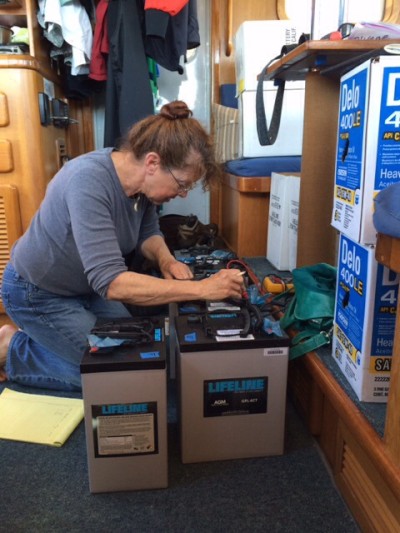D & D Nagle aboard MV DavidEllis
25 August 2022
27 May 2020 | Elfin Cove, SE Alaska
16 April 2020 | Elfin Cove, Cross Sound, Chichagof Island, SE Alaska
10 July 2019 | Elfin Cove, Alaska (or in Aussie:
18 March 2019
19 September 2017 | northbound Verney Passage, west side Gribbell Island
30 May 2017 | Photo is Meyers Chuck, north of Ketchikan AK
22 February 2017
29 August 2016 | on-the-hard, Wrangell
19 November 2015 | almost there
16 November 2015
15 November 2015
11 November 2015 | Shearwater - Bella Bella, BC
10 November 2015 | photo is approaching Bottleneck Inlet
07 November 2015
01 November 2015 | Wrangell, Alaska
17 September 2015 | Juneau to Petersburg
19 July 2015 | Wrangell > Petersburg > Tracy Arm > Juneau
28 June 2015 | Wrangell, AK (still on the hard)
03 March 2015 | Ketchikan
"Current" Project
13 August 2014 | Lovely Ms D Checks State of Charge on New Batts

Back in Sitka, 27 July - 4 Aug doing boat chores -- serviced engines, cleaned, things & stuff. And, we replaced the house battery bank. So, you say, what's the big deal there. OK, Tech Alert! here. Yeah, I know I just wrote above about the smoking alternator belt and a electrical breaker issue. For those of you who can't stand this part, go to Dorothy or my Facebook page and check out the pretty pictures.
Back to the batteries. DavidEllis, like most small boats, runs primarily on DC electrical power, like your car, not AC, like your house. We do take AC into the boat from a very big extension cord to the dock, when it's available and sometimes we make AC power with a diesel-powered generator -- our own little municipal power plant. The lights on DE, are DC, all the electronics -- radios, chart plotters, sonar, radar -- the water pumps and toilets. We produce DC electrical power from two alternators on the engine and sometimes from solar panels and or a wind generator. And sometimes we turn DC power into AC, via inverters, to watch TV, run the microwave or blender and charge stuff like phones, computers, portable radios. But mostly, everything electrical happens thanks to the house battery bank (as different than the batteries which start the main engine or the generator engine or lift the anchor chain or spin the bow-thruster prop).
Our current house battery bank is the original, installed sometime late 2005 or early 2006 at the Seahorse Marine boatyard in Dou Men, China. It consists of 4 pairs, eight total, 60-some pound each, 6 volt, AGM (acid glass matt) sealed, 225 AmpHour deep-cycle batteries. Wired in series-parallel, we end up with a 12 volt house bank of 900 AmpHours weighing about 500 pounds. In the 9 years the boat has been operational, they have given good service, but are down now to less than half their original capacity -- meaning even with close to a full charge, they will barely provide enough power for household needs on the hook, overnight before dipping below 12 volts and making the refrigerator and freezer motors very unhappy. Time to buy new batteries.
There are many ways to go on batteries, but all things considered, the most practical and least painful for us, is to replace the current set with batteries which fit the existing footprint and wiring set-up. As it turns out, there is a US manufacturer producing AGMs of almost exactly the same specifications as our current set, happily for me, being sold by Fisheries Supply, Seattle where we get a significant discount.
And, as it turns out, this manufacturer has another 6volt model, with the same footprint, but 25% greater capacity (and 30 pounds heavier per unit times 8). So after a dozen phone calls spanning two days, the new batteries were purchased out of Seattle and a week later arrived by barge, in Sitka. Oh, did I mention the price? And remember I got a good deal. The batteries cost more, significantly more, than the brand new Dodge Demon (Dart) we bought in '69 or '70. And that was before shipping.
Two full days work with very much appreciated assistance from the ever-lovely Ms Dorothy and Captain Wade and we now have 4 pairs, eight total, 90-some pound each, 6 volt, AGM (acid glass matt) sealed, 300 AmpHour deep-cycle batteries. Wired in series-parallel, we end up with a 12 volt house bank of 1200 AmpHours weighing between 700-800 pounds.
And wouldn't you know it, those two days were the most gorgeous sunny, warm days of this summer!
Comments
| Vessel Name: | DavidEllis |
| Vessel Make/Model: | Diesel Duck 462 (Seahorse Marine) |
| Hailing Port: | Sebastopol, CA, USA |
| Crew: | Mike (Dave) and Dorothy Nagle |
| About: | |
| Extra: |
Gallery not available
Who: Mike (Dave) and Dorothy Nagle
Port: Sebastopol, CA, USA
